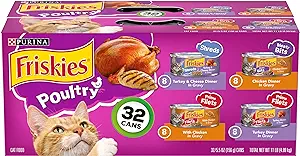Optimal Nutrition for Ragdoll Cats: What You Need to Know
This post may contain affiliate links, which means I’ll receive a commission if you purchase through my link, at NO EXTRA COST TO YOU
Ragdoll cats are known for their striking blue eyes, soft fur, and affectionate nature. As a Ragdoll cat owner, you want the best for your furry friend, starting with their diet. Proper nutrition plays a vital role in maintaining their health and well-being. In this blog, we will explore optimal nutrition for Ragdoll cats, highlighting key dietary needs, best food options, and feeding practices to ensure your Ragdoll thrives.

Understanding Ragdoll Cat Nutritional Needs
Before delving into specific dietary options, it’s essential to understand the unique nutritional needs of Ragdoll cats. Ragdolls are a larger breed, often weighing between 10 to 20 pounds. Due to their size, they require a diet rich in high-quality proteins, healthy fats, vitamins, and minerals.
Key Nutrients for Ragdoll Cats
- Protein: Ragdoll cats need a protein-rich diet to support their muscles and overall health. Look for cat foods that list high-quality protein sources, such as chicken, turkey, or fish, as the first ingredient. Ideally, protein should make up at least 30-40% of your cat’s diet.
- Fats: Healthy fats provide energy and promote a shiny coat. Omega-3 and Omega-6 fatty acids are particularly beneficial for skin and coat health. Include sources like fish oil or chicken fat in your Ragdoll’s diet.
- Carbohydrates: While cats are obligate carnivores, small amounts of carbohydrates can provide energy. However, avoid foods high in fillers like corn or wheat. Instead, opt for whole grains, such as brown rice or oats, in moderation.
- Vitamins and Minerals: Ensure that your Ragdoll receives essential vitamins and minerals. Look for cat foods fortified with taurine, vitamins A, C, E, and minerals like calcium and phosphorus. These nutrients support various bodily functions, including immune health and bone development.
Choosing the Right Cat Food
Selecting the right cat food is crucial for meeting your Ragdoll’s nutritional needs. Here are some tips to help you make informed decisions:
1. Dry vs. Wet Food
Both dry and wet cat foods have advantages and disadvantages. Dry food is convenient, helps maintain dental health, and is generally more affordable. However, it may lack moisture, which can be an issue for Ragdolls prone to urinary tract issues.
On the other hand, wet food provides additional moisture, helping keep your cat hydrated. This option often appeals to picky eaters. Ideally, a combination of both can offer balanced nutrition while addressing hydration needs.
2. Look for High-Quality Ingredients
When choosing cat food, prioritize high-quality ingredients. Avoid products with fillers, artificial preservatives, or by-products. Instead, select foods with whole meats and wholesome ingredients. Always read the label to ensure your cat receives the best nutrition.
3. Consider Age and Activity Level
Ragdoll cats’ nutritional needs may vary based on their age and activity level. Kittens require more protein and calories for growth, while adult cats need a balanced diet to maintain their health. Senior Ragdolls may benefit from lower-calorie diets to prevent weight gain. Tailor their diet to their life stage and activity level to ensure optimal nutrition.
Feeding Practices for Ragdoll Cats
Beyond choosing the right food, proper feeding practices contribute to your Ragdoll’s overall health. Here are some tips to enhance their feeding routine:
1. Establish a Regular Feeding Schedule
Creating a consistent feeding schedule helps regulate your Ragdoll’s appetite and prevents overeating. Feed them twice a day, splitting their daily food intake into two meals. This routine keeps their metabolism steady and helps maintain a healthy weight.
2. Measure Portion Sizes
Use measuring cups to portion your Ragdoll’s food accurately. Overfeeding can lead to obesity, which is a common concern for Ragdolls. Consult your veterinarian for specific portion recommendations based on your cat’s age, weight, and activity level.
3. Monitor Weight and Body Condition
Regularly monitor your Ragdoll’s weight and body condition. If you notice any changes, adjust their diet accordingly. A healthy Ragdoll should have a defined waist and should not have excessive fat covering their ribs. Consult your veterinarian for guidance if you have concerns about your cat’s weight.
4. Provide Fresh Water
Always ensure your Ragdoll has access to fresh water. Hydration is essential for overall health, especially for those eating dry food. Consider using a cat water fountain, as many cats prefer running water and may drink more frequently.
Common Nutritional Concerns for Ragdoll Cats
Despite their playful nature, Ragdolls can face specific nutritional challenges. Here are some common concerns to watch for:
- Obesity: Ragdolls are prone to obesity, which can lead to various health issues. Monitor their food intake, provide regular exercise, and consult your veterinarian if you notice weight gain.
- Urinary Tract Health: Ragdolls are susceptible to urinary tract problems. Ensure they stay hydrated and consider feeding wet food to promote urinary health. Talk to your veterinarian about specific diets designed for urinary health if necessary.
- Food Allergies: Some Ragdolls may develop food allergies or sensitivities. Common allergens include chicken, beef, and dairy. If you suspect your cat has a food allergy, consult your veterinarian for guidance on hypoallergenic diets.
Conclusion
In conclusion, providing optimal nutrition for your Ragdoll cat requires careful consideration of their dietary needs and preferences. Focus on high-quality proteins, healthy fats, and essential vitamins and minerals. By selecting the right food and implementing proper feeding practices, you can ensure your Ragdoll thrives.
As a loving pet owner, your Ragdoll’s health and happiness depend on the choices you make. Regularly consult your veterinarian for personalized advice, as they can provide insights tailored to your cat’s unique needs. With a balanced diet and proper care, your Ragdoll will enjoy a long, healthy life by your side.









